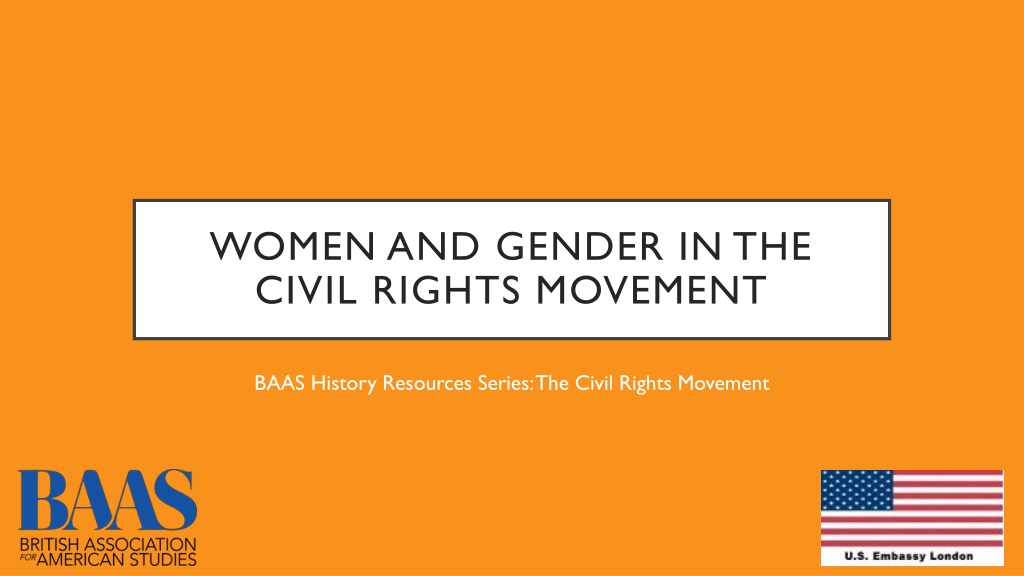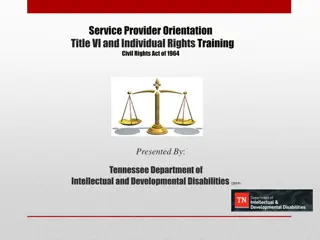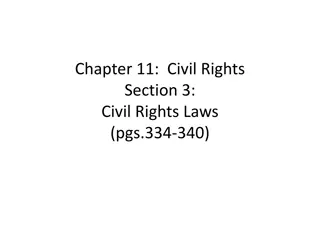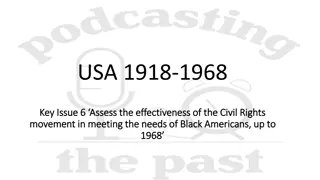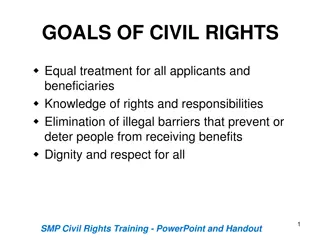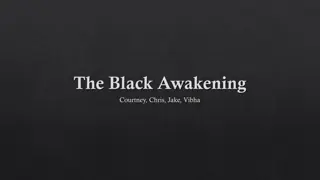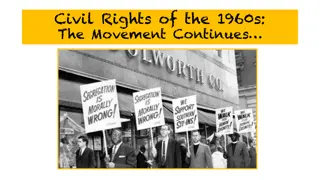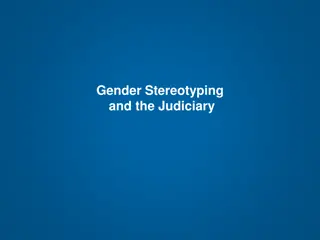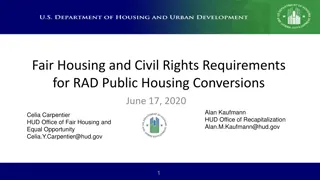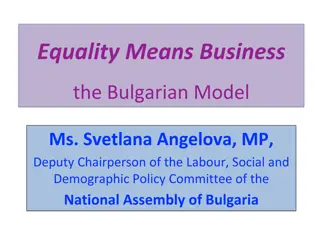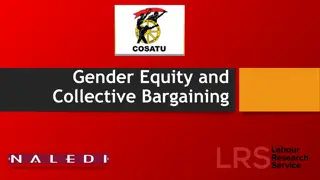Women and Gender in the Civil Rights Movement
Women played crucial roles in the Civil Rights Movement, with leaders like Rosa Parks, Ella Baker, Diane Nash, and Fannie Lou Hamer making significant contributions. Behind the scenes, many women undertook activities like organizing and grassroots activism. This resource explores the impact of women in the movement through case studies, highlighting the bravery and resilience of those involved.
Download Presentation

Please find below an Image/Link to download the presentation.
The content on the website is provided AS IS for your information and personal use only. It may not be sold, licensed, or shared on other websites without obtaining consent from the author. Download presentation by click this link. If you encounter any issues during the download, it is possible that the publisher has removed the file from their server.
E N D
Presentation Transcript
WOMEN AND GENDER IN THE CIVIL RIGHTS MOVEMENT BAAS History Resources Series: The Civil Rights Movement
WOMEN IN THE CIVIL RIGHTS MOVEMENT There were hundreds of women who took on leadership roles in the movement, including Rosa Parks, Ella Baker, Diane Nash, and Fannie Lou Hamer. However, there were also thousands of women behind the scenes who undertook the activities that enabled the movement to happen including canvassing, organizing, and other types of grassroots activism. This resource will explore the role that women played in the movement by focusing on several case studies.
On the 1stof December 1955, in Montgomery, Alabama, Rosa Parks refused to move from her seat on a segregated bus. According to the law, she should have given up her seat for the white man who was waiting to sit down. However, when she refused, she was arrested. Rosa Parks s resistance was the spark that ignited the Montgomery Bus Boycott a year of organized resistance in Montgomery that resulted in the desegregation of the buses and the propulsion of Martin Luther King, Jr. to the forefront of the movement. Lynne Olson argues that after her initial act of heroism, Rosa Parks was largely put in the role of a quiet symbol: After the bus boycott got going and King got involved, they wouldn t even let Rosa Parks speak at the first mass meeting She asked to speak, and one of the ministers said he thought she had done enough. In her book The Rebellious Life of Mrs Rosa Parks, Jeanne Theoharis argues that Parks is a far more radical figure than she is given credit for, with a lifetime of progressive politics and the resolute political sensibility that identified Malcolm X as her personal hero. Prior to the Boycott, Parks had worked with the NAACP to support victims of sexual assault. ROSA PARKS
Ella Baker was a Civil Rights Movement activist. She initially worked with King in the Southern Christian Leadership Conference (SCLC). However, she grew frustrated with its structure, including its focus on King s charismatic leadership. In 1960, during the sit-in movement, Ella Baker encouraged the students to develop independently of other organizations. She believed in participatory democracy, believing that you should empower others to lead themselves. The Student Leadership Conference made it crystal clear that current sit-ins and other demonstrations are concerned with something much bigger than a hamburger or even a giant-sized Coke. Whatever may be the difference in approach to their goal, the Negro and white students, North and South, are seeking to rid America of the scourge of racial segregation and discrimination not only at lunch counters, but in every aspect of life. - Ella Baker, from her Bigger Than a Hamburger speech, published in Southern Patriot 18 (June 1960). Baker assisted in setting up the Student Nonviolent Coordinating Committee (SNCC) in 1960. She would continue to advocate for racial justice throughout her life. ELLA BAKER
Diane Nash was a leader in the student wing of the movement, who led: sit-ins in Nashville (1960), the formation of SNCC (1960), Freedom Rides (1961), and the Selma to Montgomery March (1965). Nash was a firm believer in non-violence. She also advocated for a jail not bail approach, hoping to fill the jails with protestors until it became a liability. Nash served multiple jail sentences, including one ten-day imprisonment in Mississippi when she was pregnant. She said of the experience: I came away from the experience much strengthened. I grew spiritually through tapping in to the power of an extraordinary force through meditation. In jail I learned that I could live with very little. The oppressive authorities imprisoned me and withheld basic necessities to frighten and control me, but it backfired. They are the ones who got scared. In the end, I was freer, more determined, and stronger than ever. DIANE NASH
Fannie Lou Hamer was a grassroots activist and organizer in the Civil Rights Movement. She came from a poor family and was a sharecropper for much of her life. In 1962, Hamer attempted to register to vote, but faced deliberately difficult literacy tests and bureaucratic obstacles (e.g. poll tax receipts). When she was eventually successful, she was attacked by white racist mobs and forced to leave her home. FANNIE LOU HAMER Hamer was one of the founders of the Mississippi Democratic Freedom Party. In 1964, she spoke at the Democratic National Convention. She said: we want to register, to become first-class citizens, and if the Freedom Democratic Party is not seated now, I question America. Is this America, the land of the free and the home of the brave, where we have to sleep with our telephones off the hooks because our lives are threatened daily because we want to live as decent human beings in America? Keisha Blaine writes of Fannie Lou Hamer: Hamer s political vision was grounded in the spirit of unity, solidarity, and, most of all, action.
There are thousands of Black women who contributed to the movement, often away from the media spotlight. For instance: L. C. Dorsey set up the North Bolivar County Farm Cooperative in Mississippi. The initiative provided jobs for five hundred impoverished families and harvested more than a million pounds of vegetables in its first six months. THOUSANDS OF GRASSROOTS ACTIVISTS June Johnson was just fourteen when she joined the movement in 1962. She organized voter drives, was arrested and brutalized by police alongside Fannie Lou Hamer in 1963. Doris Derby photographed both of these women, and many others. Travelling to the South in 1963, she would take photographs of hundreds of women undertaking grassroots activism.
FOCUS ON MEN AND MASCULINITY Much of the scholarship on the Civil Rights Movement has focused on men, including leaders such as Martin Luther King, Jr.. When thinking about the Movement, King is very often focused on. The memory of the Movement often focuses on King and his iconic I Have A Dream speech. Scholars such as Peter Ling and Sharon Monteith have written about how King s masculinity made him an appealing leader, exploring the profound association of the attainment of dignity with manhood., conventionally defined. However, it is important to acknowledge the contributions and sacrifices made by Black women as well.
DIFFERENT HISTORIANS PERSPECTIVES Historians have attempted to define Black women s contributions to the Movement in many different ways: Charles Payne men led, but women organized. Women were key as on-the-ground organizers. Belinda Robnett Women are bridge leaders. Organizing is a vital form of leadership that connects local communities with national leaders. Dayo Gore, Jeanne Theoharis and KomoziWoodard Women are hidden in plain sight. Both Payne and Robnett s approaches are too limited. Women had a diverse range of roles that defy easy categorization. Defining Black women s contributions as behind-the-scenes means that their frequently radical politics are less visible.
WORKS CITED Keisha N. Blain, Until I Am Free: Fannie Lou Hamer s Enduring Message to America (Boston: Beacon Press, 2021). Emily Brady, I Take the Pictures as I See Them : Doris Derby as Womanist, Activist and Photographer in the Civil Rights Movement, Journal of American Studies 56.4 (2022): 565-588. Hands on the Freedom Plow: Personal Accounts by Women in SNCC, edited by Faith S. Holsaert, Martha Prescod Norman Noonan, Judy Richardson, Betty Garman Robinson, Jean Smith Young and Dorothy M. Zellner (Urbana, Chicago and Springfield: University of Illinois Press, 2010). Peter Ling, Gender and Generation: Manhood at the Southern Christian Leadership Conference, Gender in the Civil Rights Movement, edited by Peter Ling and Sharon Monteith (New York: Garland Publishing, 1999). Lynne Olson, Freedom s Daughters: The Unsung Heroines of the Civil Rights Movement from 1830 to 1970 (New York & London: Simon & Schuster, 2001). Charles Payne, Men Led, but Women Organized: Movement Participation of Women in the Mississippi Delta , in Women in the Civil Rights Movement: Trailblazers and Torchbearers, 1941-1965 (1993), ed. by Vicki L. Crawford et al., pp. 1-12. Belinda Robnett, African-American Women in the Civil Rights Movement, 1954-1965: Gender, Leadership and Micromobilization, American Journal of Sociology, 101 (6) (1996), 1661-1694. Jeanne Theoharis, The Rebellious Life of Mrs. Rosa Parks (Boston: Beacon Press, 2013). Want to Start a Revolution?: Radical Women in the Black Freedom Struggle, edited by Dayo F. Gore, Jeanne Theoharis and Komozi Woodard (New York: New York University Press, 2009).
